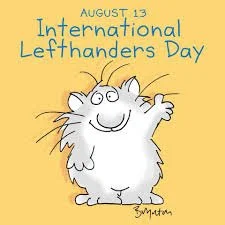AUGUST 7: NATIONAL SEA SERPENT DAY
“Here there be monsters!” Thus the maps of yore warned men at sea of unchartered waters. National Sea Serpent Day commemorates the most common monster sightings: the sea serpent. Sea serpents, also known as sea dragons, were the stuff of ancient myths. They are mythological and legendary aquatic beasts that resembled gigantic snakes. The belief in enormous sea animals was common across the ancient world, possibly inspired by the enormous oarfish, which can grow to be 50 feet long and dwell thousands of feet below the ocean’s surface. Large water species such as whales, sharks, and sea lions have also been mistaken for sea serpents.
Sea serpents abound in folklore. Cetus is the name given to the sea creature in Greek mythology. The Vikings had the Kraken. One sea serpent was adopted by the U.S. Fish and Wildlife Service for a time. A resident of the Chesapeake Bay, the horse-like sea creature named Chessie is reminiscent of another legendary serpent: Nessie of Loch Ness in Scotland. And then there are Pressie and Bessie, two Great Lake monsters. And for those who grew up watching cartoons in the late 1950s and early 1960s, there was Bennie and Cecil. Cecil was the sea monster (Bennie merely his good human friend).
AUGUST 8: NATIONAL FROZEN CUSTARD DAY
National Frozen Custard Day knows all about how to scoop up a delicious celebration. With its smooth texture and fresh flavor, frozen custard delights in many ways. Similar to ice cream, frozen custard is made with eggs in addition to cream and sugar. It’s the eggs that provide the smoother texture and keep it colder longer. The dessert comes in several flavors. Toppings include syrups, nuts, and fruits. Frozen custard is the cornerstone of many franchises and custard shops across the US, providing a satisfying version of ice cream. Because of the egg yolk, frozen custard must be carefully prepared, commonly fresh at the place of sale.
Ice cream vendors, Archie and Elton Kohr invented frozen on Coney Island in 1919. On their first weekend, the Kohr brothers sold 18,640 cones. Its popularity grew in 1933 when frozen custard found a market at the Chicago World’s Fair. While Coney Island and Chicago are key to the popularity of frozen custard, it is Milwaukee, Wisconsin that has become known as the (unofficial) frozen custard capital of the world. Go figure . . .
AUGUST 9: NATIONAL HAND HOLDING DAY
National Hand Holding Day was created to encourage people to — what else? — hold hands. It is a way to emphasize the importance of touch and encourage affection towards loved ones. Holding hands is not only limited to romantic relationships but is a warm gesture that happens between grandparents and their grandchildren, parents and their children, a way of reassuring and guiding the young through the world. It’s also a means of providing physical support to the elderly.
Although the origins of National Hand Holding Day are unknown, holding hands is common among most cultures. It can be done as a sign of love, friendship, or solidarity. Not restricted to lovers, it expresses affection for both siblings and friends. Scientific research has linked holding hands with the release of a hormone called oxytocin, a peptide hormone produced in the hypothalamus region of the human brain activated when neurons experience electrical activity, which results in the hormone being released into the bloodstream. Oxytocin plays a major role in the female reproductive system, especially during pregnancy and lactation. However, the hormone is also released during physical activities such as exercise and hugging. What does all this scientific discussion come down to? Short answer: stress reduction and decreased anxiety levels. Not bad for one little hormone.
AUGUST 10: NATIONAL LAZY DAY
National Lazy Day gives us license to relax and kick back. Where did National Lazy Day come from? Who cares? Could we research this? Sure, but no. The terrace and a good book calls. Add a cold drink, and, voila!, nirvana. The pool cries out for attention. Just float and relish the experience. Turn on a good movie in your apartment, add prepackaged popcorn (popping is just so exhausting), and wile away the time.
According to scientific research (done by others), some people are born with a “laziness gene.” This gene mutation is linked to dopamine receptors in the person’s brain. Since dopamine is intimately linked to a person’s willingness (or lack thereof) to perform physical activities, that can be a reason some people are lazy. Lucky them!
Laziness can lead to increased creativity, since when a person is working, the brain is consumed with solving the task at hand, blocking imaginative, creative thought. Only when the brain is at rest can its awesome imaginative powers be set free.
Take this test to prepare yourself for the day: Lazy people fact #72432143726413424. If you were too lazy to read that number, you’re ready to celebrate this day.
AUGUST 11: WORLD STEELPAN DAY (Year 1)
The steelpan — a musical instrument originating in Trinidad and Tobago (T&T) — goes by more than one name: a pan, a steel drum, and, of course, a steelpan. When several steelpan musicians — known as “pannists” – come together to play, they’re called a steel band or a steel orchestra. Steelpans had their origin in the early-to-mid 1900s, but their roots go back much further to the talking drums of West African cultures. When French planters arrived in T&T in the 1700s, they brought the carnival tradition. Their West Africans slaves formed their own festival, incorporating the drum beats of their heritage. Their first instruments were tamboo bamboos. Hitting them on the ground made sound that could be tuned. In the 1930s, the tradition turned to the steelpan, originally made with metal objects, including car parts, paint pots, dustbins, oil drums, and cookie tins. A series of dents hammered into the metal surface create a different note according to its position and size. The 55-gallon oil drum was adapted to make steelpans in the late 1940s. The Trinidad All-Steel Pan Percussion Orchestra (TASPO), formed to attend the Festival of Britain in 1951, was the first steel band whose instruments were all made from oil drums. With them, they introduced the steelpan and a new music genre to the world.
The steelpan’s tonal versatility can be used equally effectively to play soca, calypso, rapso, reggae, and jazz, as well as more complex compositions like the music of Bach, Beethoven, and Mozart. Such renditions have attracted audiences in the local “Panyards” — steelpan arenas in T&T — as well as in the most prestigious concert halls worldwide, such as Carnegie Hall, the Royal Albert Hall, and the Kennedy Center.
Steelpan Day was created by Pan Trinbago, the world’s steelpan governing body. In 2022, no less august body than the United Nations joined in, creating the first World Steelpan Day. 2023 is its first year. Randall Mitchell, T&T Minister of Tourism, Culture and the Arts introduced the resolution for its creation to the UN General Assembly, saying the steelpan represents more than musical versatility to the T&T people. “It is emblematic of artistic excellence, community empowerment, endurance, self-determination, community, culture, heritage and identity and not least of all national pride,” noting that the instrument has been adopted throughout the Caribbean.
Some universities in Europe, Canada, and the US have academic programs dedicated to steelpan music. It is also part of Sleepy Hollow history. The Philipse Manor Brute Force Steel Band was founded in 1965. Dis-banded in the late 1980s, it was rejuvenated by a group at Christ Church, Tarrytown.
AUGUST 12: TRUCK DRIVER DAY
Professional truck drivers are honored and celebrated with Truck Driver Day. Truck drivers carry all kinds of freight — livestock, food, canned goods, liquids, packages, vehicles — across the US and the world. They often must load and unload freight, as well as inspect their trucks before hitting the road. Long hours are not unusual. Some drivers have local routes close to home, while others have routes and schedules that often change, taking them away from home for a long time.
In the US, a truck driver drives a vehicle with a gross vehicle weight — the weight of the vehicle loaded — of at least 26,000 pounds. They must have a commercial driver's license. Employers often require drivers to take a safety training program, and some also require a high school degree or GED.
Trucks were hauling goods in and around the US before WWI. Trucks continued to be used and developed during the war, and by 1920 more than a million trucks were on US roads. Trucking continued to expand over the next decade, due to advancements like diesel engines, improved rural roads, the power brakes and steering, and standardization of truck and trailer sizes. In the 1930s, a number of trucking regulations were set, and the American Trucking Association was created. Trucking activity increased in the 1950s and '60s, in large part due to the creation of the Interstate Highway System.
The heyday of the truck driver came in the 1960s and '70s. The rise of "trucker culture" was signaled with the proliferation of trucker songs and films, the wearing of plaid shirts and trucker hats by the public, and the wide use of CB radios and CB slang. That subsided by the dawn of the 1980s.
The Motor Carrier Act of 1980 partially deregulated the industry. As a result, new trucking companies were started. Trucker union membership also declined, as did pay. But the deregulation also reduced consumer costs, and increased production and com-petition in the industry. By the 21st century, trucking dominated the freight industry. In 2006, there were 26 million trucks on America's roads, hauling about 70% of the country's freight. During the pandemic’s close-down, local and cross-country truckers were part of that very special group known as “essential workers.” Truckers continue to play a prominent role in keeping the wheels of the economy turning. And for the hard work they put in to make this happen, they are honored and celebrated today!
AUGUST 13: INTERNATIONAL LEFTHANDER’S DAY
Left-handers include Presidents Harry Truman, John Kennedy, Ronald Reagan, Bill Clinton, and Barack Obama. Many famous people in history are left-handed, including Julius Caesar, Aristotle, Alexander the Great, Mahatma Gandhi, Leonardo de Vinci, Michelangelo, and Napoleon. Also count in King Charles, and Lady Gaga. Paul McCartney and Jimi Hendrix were the world’s greatest left-handed guitarists. In baseball, legendary “southpaws” include Babe Ruth and Sandy Koufax.
International Lefthanders Day 2021 celebrates the differences and distinctiveness of left handed individuals. It was first celebrated in 1976 by Dean R. Campbell, founder of the Lefthanders International, Inc., to recognize all individuals who have mastered using their left hand in a right-handed world.
Approximately 10% of the population are southpaws. Why? Nobody knows. It’s more likely a child will be left-handed if one parent is. Parents of left-handed children used to force them to use their right hands. In their eyes, the predominant use of the left hand seemed evil. It didn’t help that the Latin word for “left” is “sinister.” During the 1600s, people thought left-handers were witches and war-locks. Parents feared their communities would shun their children. Today, we accept left-handedness more readily than in yore.
In a world designed for right-handeders, lefties adapt well. It ain’t easy being a leftie. In school, left-handed desk don’t exist. Scissors are for right-handers. The computer mouse is designed for right-handed users, too. Lefties have certainly earned the right to a day dedicated to them.
Right-handed people operate from the left side of the brain. Left-handed people use the right side. Therefore, only left-handed people are in their right mind. Think about that . . .







